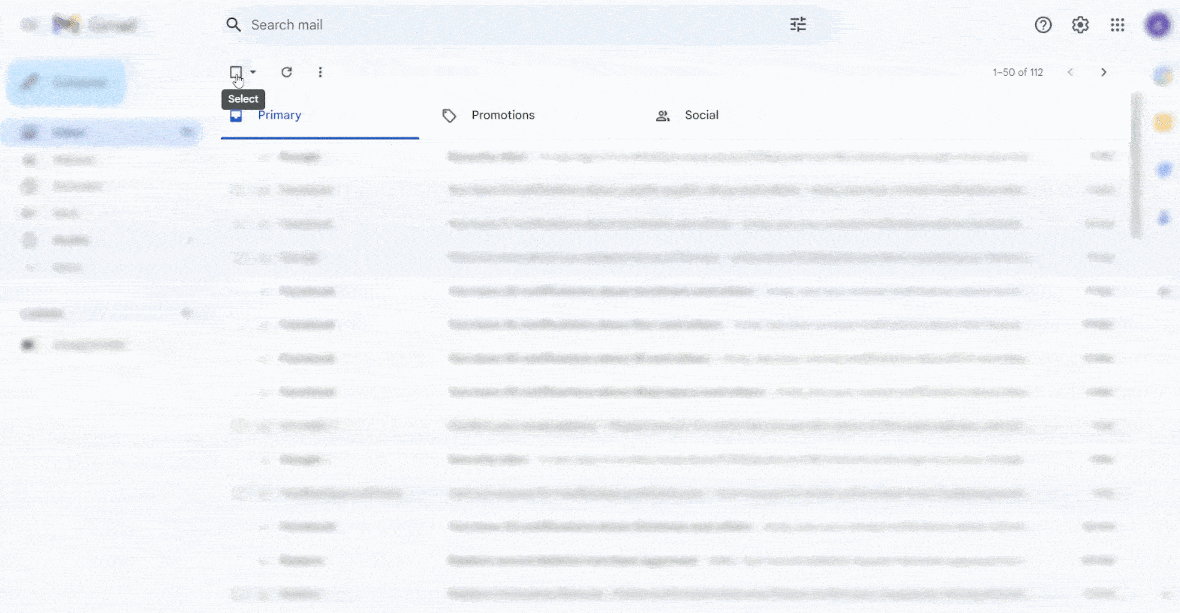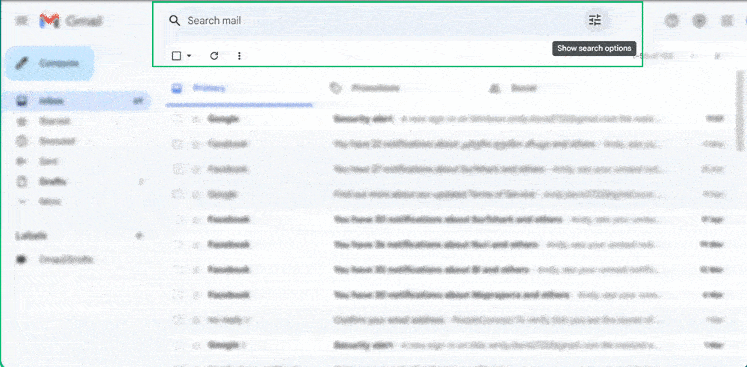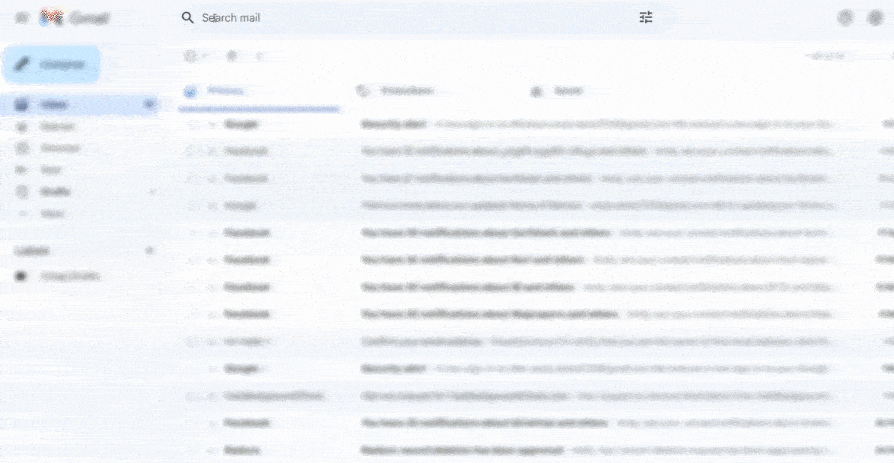How to clear your Gmail inbox
We’ve all been there—
Carelessly storing emails in your Gmail inbox and doing just fine.
Until that message pops up: “You’ve used 95% of your storage.”
Now, it’s time for a cleanup.
That means filtering the important emails from thousands of junk messages.
But with a few search operators, you should be able to get a handle on things and restore order.
And here’s the good part—
We’re about to show you how.
Let’s get into it!
Table of Contents
Prevent future junk mail from arriving
Cleaning out your Gmail is just a band-aid solution.
After a while, your inbox will be jam-packed with spam again.
Instead, opt for a permanent solution.
Hundreds of data brokers are trading your personal information, including your email address.
Taking your data off their hands can put a stop to spam emails.
Sign up for Incogni—a professional data removal service. We’ll handle everything, so you can enjoy a clutter-free inbox.
How to delete all emails in Gmail

Sometimes, radical solutions are the best.
There’s a quick way to delete all emails from Gmail at once:
- Check the small box underneath your Gmail search bar in the inbox panel.
- Now, click on the “select all x messages” in the upper part of your inbox.
- Click the “delete” button that looks like a trash can—it’s a bit to the right of the arrow from Step 1.
And it’s gone. However, deleting thousands of emails like this may take a while.
You can perform this process for your entire inbox or selected categories, labels, and folders—just go to the location you want cleaned up and follow the same steps.
Now your emails are in the trash folder and you have 30 days to change your mind—after that period, Gmail will permanently delete emails stored in the bin.
You can speed this process up, though.
Just enter the trash folder and click on “empty trash now”—that’ll delete all messages.
Alternatively, you can select any messages you want and then click “delete forever.”
Important: Google usually takes 24–48 hours to update your storage space. Thus, you may still receive the low storage message for a while, even after deleting all emails.
How to delete all emails at once using a phone
If you want to mass-delete emails from your Gmail mobile app, here’s what you need to do:
- Tap and hold any email in your Gmail inbox to select it.
- Once highlighted, tap the “select all” checkbox (if it’s not visible, update your app).
- Initially, Gmail will select only the first 50 messages. If you have more, scroll to the bottom of the selection and tap “select all” again.
- Continue this process until you’ve selected all the emails you wish to delete—Gmail selects messages in batches of 50.
- Finally, tap the “delete” icon—it looks like a trash can.
That’s it.
If you want to delete emails only from a specific category (Social, Promotions, etc.), head to that category and perform all the steps above.
The same approach applies to labels and folders.
Until recently, the Gmail app had no “select all” option on mobile devices.
So, if you don’t see the “select all” button, try updating your app.
Oops, did you delete one too many emails?
Just head to the trash folder to recover deleted emails. You have 30 days to change your mind.
To access the trash folder, tap on the “menu” icon in the top-right corner and scroll down until you see a bin icon—that’s your trash folder.
How to clear Gmail inbox selectively
Although deleting all your emails at once saves time, you might accidentally erase some important messages.
It may be better to find all the emails you want to delete:
- Use built-in search options—very easy to do, moderate customization, desktop only.
- Use search operators—easy to do, great customization, available on desktop and mobile.
Here’s how to clean out your Gmail inbox with more control.
Clean Gmail inbox with “show search options”
Search options allow you to filter your emails by date, sender, size, and more.

To access search options, click on the “show search options” button at the right of the Gmail search box window.
This will open a window with multiple options.
Customize your search filters to catch all the emails you want to select without including any of the ones you want .
If you’re not sure where to start, here’s some advice:
- Start with “heavy” emails. Using the “size” filter, leave only those emails that exceed 20MB and delete all the unnecessary ones; then, repeat with smaller sizes.
- Clean up old emails. Use “date within 1 year” and set a date of your choosing, e.g., 2013/04/29—now, you’ll see only emails sent within one year of that date. Very old emails are probably all junk.
- Search by content. Use “has the words” and type in some key phrases, e.g., “unsubscribe,” “sale,” or “promotion”—now you’ll see mostly marketing emails. You can delete them all at once if you’re sure there’s nothing important there.
You can tailor these options to your needs and get your inbox back in order relatively quickly.
However, there are still some limitations. For example, you can’t filter only unread messages or all emails older than a particular age.
To do so, you’ll need to use search operators.
It’s easier than you think.
See below how it’s done.
Clean Gmail account with search operators

When you use the advanced search option, you’re already using search operators—it’s just that they’re automated by Google.
But you can achieve even better results by using these operators yourself.
Here’s a ready-made search term you can use.
older_than:2y has:nouserlabels is:unread -in:drafts -in:inbox -in:starredJust copy-paste it to the Gmail search bar (on desktop or mobile) and hit enter.
What do you get?
All unread emails that are older than two years and aren’t labeled.
If you haven’t read them yet, there’s a good chance you don’t need them, right?
Just select them all and delete them.
You can customize this command to your liking, for example, changing the range to 1 year (1y), 6 months (6m), or any other period.
You can also view emails you have read—simply change the command from “is:unread” to “is:read.”
older_than:2y has:nouserlabels is:read -in:drafts -in:inbox -in:starredYou still have to go through the messages yourself, though. There’s no way around that, unfortunately.
Important: This option works best if you have used labels or stars to mark important emails. Otherwise, important email will be mixed in with junk emails.
If you wish to filter your inbox in an even more advanced manner, take a look at this overview of some useful commands:
| Search operator | Example | Effect |
| older_than:[numerical value][mark] | older_than:2Y D – daysM – monthsY – years | This operator shows all emails that are older than the set age. In the example, you’ll see only emails that are older than two years old. |
| after:yyyy/mm/dd before:yyyy/mm/dd | after:2013/04/01 before:2015/04/01 | These operators show all emails sent either after or before the set date. You can use these operators together to filter emails sent within a specific time window. In the example, you’ll see emails sent between April 2013 and March 2015. |
| is:[mark] | is:unread Other marks:readimportantstarredunstarred | This operator allows you to filter emails with specific qualities. In the example, you’ll see only unread emails. |
| in:[mark] | in:drafts Other marks:sentinbox spamstarred | This operator shows you emails in the indicated folder. In the example, you’ll see only emails that are in the Drafts folder. |
| has:[mark] | has:nouserlabels Other marks:attachmentspdfyoutube | This operator shows only those emails that have the indicated quality. In the example, you’ll only see emails that have no label. |
| keyword “keyword” | update “update” | This operator allows you to search for specific words in emails—just type in the keyword. If you put words in quotation marks, Gmail will search for exact matches. Otherwise, it’ll also consider partial matches. In the examples, you’ll see emails that contain the words “date” and “update” or only “update.” |
| –[search command] | -in:spam | Using the minus symbol before your search command excludes that result. In the example, you’ll see all emails except those in the Spam folder. |
| [search command 1] AND [search command 2] [search command 1]space[search command 2] | has:nouserlabels and –in:spam has:nouserlabels –in:spam | The operator “AND” will only bring up results that contain BOTH terms. The same effect happens when you place two commands separated by a space (since Gmail’s default behavior is to treat a space as an “AND” operator). In the example, you’ll see all emails that have no labels and are not in Spam. |
| [search command 1] OR [search command 2] | subscription or “update” | The operator “OR” will lead you to results that contain EITHER term. In the example, you’ll see all the emails that contain the word “subscription” and all the emails that contain “update” (including those that contain both terms). |
These are just a few possible commands. If you want to learn more, visit Google’s guidelines.
But don’t stop at mass-deleting emails only.
You can take a few simple steps to keep your Gmail clean and tidy.
How to keep your Gmail inbox clean
We’ve compiled a short list of good practices to help keep your Gmail inbox organized and clean.
- Activate inbox categories—Gmail offers you the option to automatically sort your emails into thematic categories, such as “Primary,” “Social,” or “Promotions.” Doing so will help you maintain order—for example, you can bulk delete notifications from social media with just one click.
- Use labels—create labels to organize your emails, for example for invoices or work-related matters. This will help you filter out junk email in the future.
- Unsubscribe from mailing lists—tap “unsubscribe” next to the sender’s name and repeat for each mailing list you want to quit.
- Block unwanted senders—if you’re receiving aggressive marketing or never-ending spam, simply block the sender’s email address.
- Get your email removed from data brokers—companies that sell your personal data to marketers. Removing your email from their databases can prevent future junk emails from arriving.
Related articles
- How to unsubscribe from emails on Gmail in bulk
- How to stop spam emails in Gmail
- How to clear your Gmail inbox
- How to delete multiple emails in Gmail on phone
- How to delete all promotions in Gmail
- How can I create a Gmail account for my child?
- How to delete your Gmail account?
- Can I change my Gmail address?
How to clear inbox on Gmail: FAQ
What is the fastest way to clean out my Gmail inbox?
The fastest way to clean your Gmail inbox is to delete all messages.
(1) Check the small box underneath the search bar, (2) click “select all x messages,” and then (3) click “delete.”
If you want to have more control, consider these tips:
– Type older_than:2y into the search bar to filter for emails older than two years. You can replace “2y” with different time frames like “1y” for one year, “6m” for six months, etc.
– Similarly, use the is:unread query to see only unopened emails. You can combine this query with the one above by typing them both into the search bar, separated by a space.
– Consider cleaning out your inbox’s “Social” and “Promotions” categories—these often contain spammy notifications and offers.
How to permanently delete emails from Gmail
Once you delete emails in Gmail, they go to the Trash folder and stay there for 30 days.
To delete emails from Gmail permanently: (1) in your Gmail inbox, click on “more” in the left-hand panel, (2) go to “trash,” and (3) select “empty trash now.”
This action will permanently erase the entire contents of your trash folder.
Alternatively, you can select messages individually and then click “delete forever.”